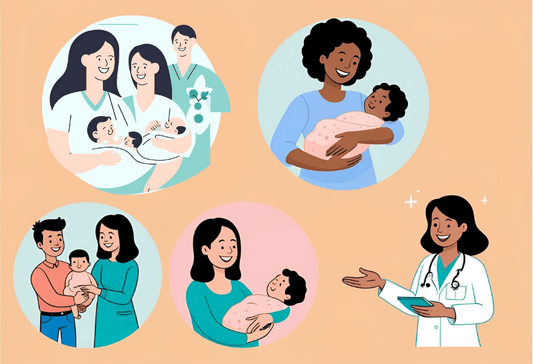March 21, 2025 | Artificial Insemination | Conception
Artificial Insemination Trends: Current Social Trends and Evolution

A New Era of Family Building
Artificial insemination (AI) has long been a medical intervention designed to aid conception, but in recent years, societal attitudes and trends have reshaped its role in family planning. Once considered an option primarily for couples facing infertility, artificial insemination now plays a key role in giving individuals control over how they birth their baby, offering pathways to parenthood for diverse family structures, including single parents by choice and LGBTQ couples.
Breaking the Traditional Mold
Historically, artificial insemination was largely utilised by heterosexual married couples struggling with male infertility. The process was often shrouded in secrecy due to social stigma, and donor anonymity was the norm. However, shifting social values and evolving family dynamics have broadened its accessibility and acceptance. Today, artificial insemination is not just about medical necessity—it’s now also about reproductive choice.
The rise of single parenthood by choice has significantly contributed to the growing demand for artificial insemination. More individuals, particularly single women, are opting for sperm donation to build their family on their own terms, free from traditional timelines and relationship constraints. This trend has been fuelled by greater financial independence, changing gender roles, and a growing support network for solo parents.
Likewise, LGBTQ couples have played a crucial role in normalising artificial insemination as a viable and celebrated means of family building. The legalisation of same-sex marriage and the increasing visibility of queer families have led to more inclusive reproductive services. Fertility clinics now offer tailored support for same-sex couples, with donor sperm and reciprocal IVF (where one partner carries the pregnancy using the other’s egg) becoming commonplace.
The Evolution of Donor Anonymity and Ethics
In the past, sperm donation was typically anonymous, with donors and recipients having little to no contact or identifying information. However, the rise of at-home DNA testing services has made complete anonymity nearly impossible. Many donor-conceived individuals are using platforms like 23andMe and AncestryDNA to uncover their genetic heritage, leading to ethical and legal debates about the rights of donor-conceived children to know their biological origins.
As a result, many countries have shifted towards open-donor policies, allowing donor-conceived children access to identifying information once they reach adulthood. This transparency aligns with broader societal trends that value identity, connection, and the right to genetic knowledge. Some countries, such as the UK and Australia, have legally mandated the end of anonymous sperm donation, while others are gradually moving in that direction. Read below the ethical breaches in the case of Dr. Burton Caldwell……
The Rise of Private Sperm Donation and Crowdsourced Conception
One of the most intriguing shifts in the artificial insemination landscape is the rise of private sperm donation. Online platforms and social media groups (read this article to check out the only Facebook sperm donation group we recommend in NewZealand) now connect donors directly with recipients, bypassing traditional sperm banks and fertility clinics. This movement has been driven by high costs associated with clinical insemination, long donor waitlists, and a desire for more personalised donor-recipient relationships.
While this direct approach offers greater autonomy, it also raises concerns about safety, frauds, legal rights, and medical screening. Without proper regulation, recipients may face legal grey areas regarding parental rights, and there are increased risks of insufficient medical screening for genetic or infectious diseases. As this trend grows, there is an ongoing debate about the need for greater oversight without undermining reproductive freedoms.
The Future of Artificial Insemination
As societal attitudes continue to evolve, artificial insemination is expected to become even more integrated into mainstream family planning. Advances in reproductive medicine, combined with shifting legal and ethical frameworks, will likely expand accessibility while refining regulations to balance autonomy with safety.
Moreover, as conversations about reproductive justice continue to grow, there is increasing pressure to make fertility treatments like IVF more accessible and inclusive. The high costs of these procedures often restrict access to those with financial privilege, leaving many individuals and couples unable to pursue parenthood through medical assistance. As a result, many turn to at-home artificial insemination as a first step before seeking fertility treatments or IVF. This method typically involves using a sterile, needleless syringe or a cervical cap to introduce sperm into the vagina, often with sperm from a known donor or a sperm bank (you can get everything you need for at home insemination by purchasing the stellar insemination kit).
Artificial insemination has come a long way from being a discreet solution for infertility to a mainstream, socially accepted means of family creation. The landscape has shifted towards inclusivity, transparency, and personal agency, reflecting broader cultural changes in how we define family and reproduction. However, cases like Dr. Burton Caldwell’s serve as stark reminders of the ethical concerns that must be addressed. As science and society continue to evolve, artificial insemination will remain at the forefront of discussions around reproductive autonomy, ethics, and accessibility—shaping the future of family-building for generations to come.
If you need help going through any block, talking with a TTC consultant can help! Book a FREE 15 minute virtual consult today!
Featured Product

Hapū Helpers
The Stellar - Insemination Kit






